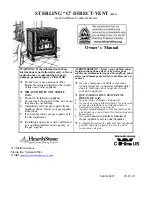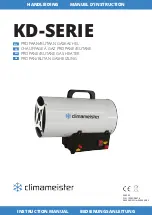
39
DOWFROST HEAT TRANSFER FLUID PROPERTIES
Potential Health Effects
Eye Contact: May cause slight temporary eye irritation. Corneal injury is unlikely.
Skin Contact: Prolonged contact is essentially nonirritating to skin. Repeated contact may cause fl aking and softening of skin.
Skin Absorption: Prolonged skin contact is unlikely to result in absorption of harmful amounts.
Inhalation: At room temperature, exposure to vapor is minimal due to low volatility. Mist may cause irritation of upper respiratory tract (nose and throat).
Ingestion: Very low toxicity if swallowed. Harmful effects not anticipated from swallowing small amounts.
Effects of Repeated Exposure: In rare cases, repeated excessive exposure to propylene glycol may cause central nervous system effects.
Component CAS
#
Amount
Propylene glycol
57-55-6
> 95.0 %
Dipotassium hydrogen phosphate 7758-11-4
< 3.0 %
Deionized water
7732-18-5
< 3.0 %
First-aid measures
Eye Contact: Flush eyes thoroughly with water for several minutes. Remove contact lenses after the initial 1-2 minutes and continue fl ushing for several additional min-
utes. If effects occur, consult a physician, preferably an ophthalmologist.
Skin Contact: Wash skin with plenty of water.
Inhalation: Move person to fresh air; if effects occur, consult a physician.
Ingestion: No emergency medical treatment necessary.
Notes to Physician: No specifi c antidote. Treatment of exposure should be directed at the control of symptoms and the clinical condition of the patient.
Accidental Release Measures
Steps to be Taken if Material is Released or Spilled: Small spills: Absorb with materials such as: Cat litter. Sawdust. Vermiculite. Zorb-all®. Collect in suitable and prop-
erly labeled containers. Large spills: Dike area to contain spill. Recover spilled material if possible.
Handling and Storage
Handling
General Handling: No special precautions required. Keep container closed. Spills of these organic materials on hot fi brous insulations may lead to lowering of the autoig-
nition temperatures possibly resulting in spontaneous combustion.
Storage
Do not store in: Galvanized steel. Opened or unlabeled containers. Store in original unopened container.
Exposure Controls / Personal Protection
Exposure Limits
Component List Type Value
Propylene glycol
Personal Protection
Eye/Face Protection: Use safety glasses.
Skin Protection: Wear clean, body-covering clothing.
Hand protection: Use gloves chemically resistant to this material when prolonged or frequently repeated contact could occur. Examples of preferred glove barrier materi-
als include: Butyl rubber. Natural rubber ("latex"). Neoprene. Nitrile/butadiene rubber ("nitrile" or "NBR").
Respiratory Protection: Respiratory protection should be worn when there is a potential to exceed the exposure limit requirements or guidelines. If there are no appli-
cable exposure limit requirements or guidelines, wear respiratory protection when adverse effects, such as respiratory irritation or discomfort have been experienced, or
where indicated by your risk assessment process.
Physical and Chemical Properties
Physical State Liquid
Color Colorless
Odor Characteristic
Flash Point - Closed Cup 104 °C (219 °F) Pensky-Martens Closed Cup ASTM D 93 (based on major component), Propylene glycol
Flammable Limits In Air Lower: 2.6 %(V) Literature Propylene glycol
Upper: 12.5 %(V) Literature Propylene glycol
Autoignition Temperature 371 °C (700 °F) Literature Propylene glycol
Vapor Pressure 2.2 mmHg Literature
Boiling Point (760 mmHg) 152 °C (306 °F) Literature .
Vapor Density (air = 1) >1.0 Literature
Specifi c Gravity (H2O = 1) 1.05 20 °C/20 °C Literature
Freezing Point supercools
Melting Point Not applicable to liquids
Solubility in Water (by weight)
100 % Literature
pH 10.0 Literature
Kinematic Viscosity 43.4 cSt @ 20 °C Literature
Disposal Considerations
DO NOT DUMP INTO ANY SEWERS, ON THE GROUND, OR INTO ANY BODY OF WATER. All disposal practices must be in compliance with all Federal, State/Provin-
cial and local laws and regulations. Regulations may vary in different locations. Waste characterizations and compliance with applicable laws are the responsibility solely
of the waste generator.
Regulatory Information
OSHA Hazard Communication Standard
This product is not a "Hazardous Chemical" as defi ned by the OSHA Hazard Communication Standard, 29
CFR 1910.1200.
Superfund Amendments and Reauthorization Act of 1986 Title III (Emergency Planning and Community Right-to-Know Act of 1986) Sections 311 and 312
Immediate (Acute) Health Hazard
No
Delayed (Chronic) Health Hazard
No
Fire Hazard
No
Reactive Hazard
No
Sudden Release of Pressure Hazard
No
Содержание SRCC OG-100
Страница 3: ...3 GENERAL SAFETY...
Страница 40: ...40...


































